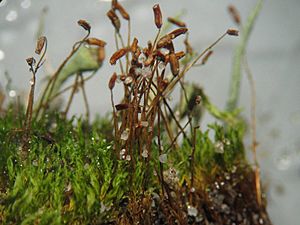Ceratodon purpureus facts for kids
Quick facts for kids Ceratodon purpureus |
|
|---|---|
 |
|
| Scientific classification | |
| Genus: |
Ceratodon
|
| Species: |
purpureus
|
| Synonyms | |
|
Ceratodon dimorphus |
|
Ceratodon purpureus, often called fire moss, is a common moss found all over the world. It gets its name "fire moss" because it's one of the first plants to grow back after a wildfire. This moss can be yellow-green or even reddish-purple. It usually grows up to 3 centimeters (about an inch) tall.
You can find fire moss almost everywhere, especially in cities and next to roads. It likes dry, sandy soil. This tough little plant can grow in many different places, from polluted highway edges and old mining sites to areas recently burned by wildfires. It even grows on the bright, sunny slopes of Antarctica! Besides fire moss, people also call it redshank, purple forkmoss, ceratodon moss, and purple horn toothed moss.
Contents
What It Looks Like
Fire moss is a small moss that grows in thick clumps, like tiny green or red cushions. Its stems stand up straight, usually about 1.3 cm (half an inch) tall. The top part is new growth, and sometimes the stems split into two at the end. In shady spots, it can grow taller, up to 7-8 cm (about 3 inches).
Its leaves are short and thin, like tiny hairs. They spread out when wet and curl up when dry. Fire moss has special colors (pigments) that protect it from bright sunlight, which is helpful in places like Antarctica. Its leaves can be green or even a reddish-orange color.
Where It Lives
You can probably find fire moss in almost every country around the world. It's very common across Canada and the United States, found in every province, territory, and state.
Fire moss can handle much more pollution than most other mosses. You often see it in cities, near factories, along busy roads, and even on leftover piles from coal and metal mining.
This moss is often found in places where the ground has been disturbed. It can grow on many surfaces, including soil, rocks, wood, old roofs, sand, and even in cracks in sidewalks. It grows best on exposed, firm, dry, gravelly, or sandy soils, but it can live in many different types of soil. In Scotland, fire moss grows between grass shoots on sand dunes near the water.
How It Grows
Fire moss has separate male and female plants. It reproduces in two main ways:
- Spores: Like tiny seeds, spores are released from capsules.
- Vegetative reproduction: It can also grow new plants from thread-like or plate-like growths called protonemata.
The capsules that hold the spores are on the end of a long stalk, called a seta. These capsules usually stick out sideways. Fire moss often produces lots of these capsules. Wind is the main way its spores spread.
When fire moss spores land, they first swell up, then stretch out before growing. The long stalks (setae) twist and untwist as the air gets wetter or drier. This movement helps to shake the capsules, releasing the spores. The capsules also have grooves that might squeeze out spores when they are ready. Amazingly, fire moss spores can still grow even after being dry for 16 years!
New fire moss plants (sporophytes) start to appear in early spring, as soon as the snow melts. By March, the stalks reach their full height and turn from green to red. The capsules are ready by late spring. By midsummer, the capsules often break apart, and the stalks fall off the moss.
Moss and Springtails: A Team Effort?
In 2012, scientists discovered something cool: male and female fire moss plants give off different smells. Female plants release more kinds of smells than male plants. Tiny insects called springtails seem to prefer the female plants. The study found that these springtails actually help the moss get fertilized! This suggests that mosses might have a relationship with insects, similar to how flowers use bees to spread pollen.
Its Role in Nature
Fire moss likes places where there isn't much competition from other plants and where there's plenty of sunlight. However, it can handle some shade. It's a "pioneer" plant, meaning it's one of the first to move into disturbed areas, like bare soil, using its spores.
You'll often find fire moss growing with other plants that like disturbed sites, such as fireweed and pearly everlasting. Over time, as an area recovers, flowering plants often replace fire moss. In the black spruce forests of Alaska and Canada, fire moss is a main plant during the first 1 to 20 years after a disturbance. It continues to grow more during the early shrub stage but starts to decrease later on.
Fire moss can quickly grow in burned areas because its spores are light and can be carried far by the wind. A very hot fire, which leaves bare soil, creates perfect conditions for fire moss spores to sprout. Fire moss is often the main plant for several years after a severe fire. It produces some spores late in the first year after a fire and many more in the second year. If a fire happens in early spring, new moss plants can grow in just 4 to 5 months. If the fire happens in the fall, it takes a bit longer for the moss to grow.

